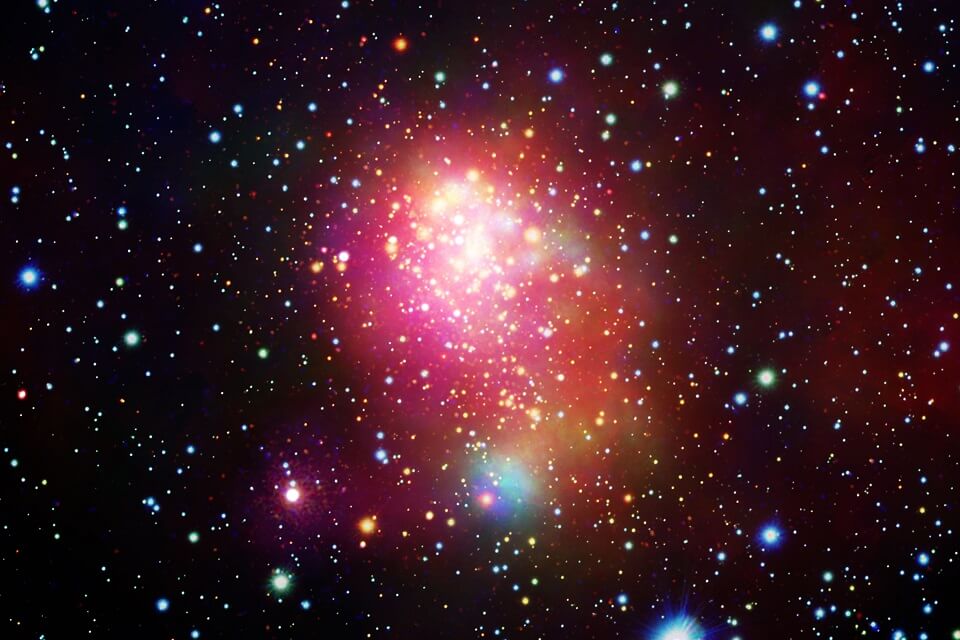Researchers reveal new pictures of supermassive star cluster close to Earth

- An international research team including a Keele scientist have published new images of Westerlund 1 - one of the most massive star clusters in our galaxy, the Milky Way;
- The new pictures were created by blending data from the Hubble Space Telescope and NASA's Chandra Observatory;
- Only a few super star clusters like Westerlund 1 still exist in our galaxy, but they offer important clues about an earlier era when most of our galaxy’s stars formed.
Studying a supermassive star cluster
An international research team including a Keele scientist have published new images of one of the most massive star clusters in our galaxy, the Milky Way, which is helping them learn more about how stars are formed in our galaxy.
The Westerlund 1 star cluster, which is around 13 thousand light years away from Earth and is estimated to be around between 3 and 5 million years old, is one of the fascinating stellar objects being studied by the Extended Westerlund 1 and 2 Open Clusters Survey (EWOCS) project, which is co-authored by Keele’s Dr Nick Wright.
The new pictures, published alongside a paper in the journal Astronomy and Astrophysics, were created by blending data from the Hubble Space Telescope and NASA's Chandra X-ray Observatory.
By combining the X-Ray observations from Chandra, with optical images from Hubble, the scientists have revealed new details about the structure of the cluster and how many stars are concentrated within it.
A window into our galaxy’s past
Currently, only a handful of stars form in our galaxy each year, but in the past the Milky Way used to produce many more stars. Scientists estimate it hit a peak of producing dozens or even hundreds of stars per year about 10 billion years ago, and then gradually declined ever since.
Astronomers think that most of this star formation took place in massive clusters of stars, known as “super star clusters,” like Westerlund 1. These are young clusters of stars that contain more than 10,000 times the mass of the Sun.
Only a few super star clusters still exist in our galaxy, but they offer important clues about this earlier era when most of our galaxy’s stars formed. Westerlund 1 is the most massive of the remaining super star clusters in the Milky Way and contains a mass equivalent to between 50,000 and 100,000 Suns. It is also the closest super star cluster to Earth at about 13,000 light-years.
These qualities make Westerlund 1 an excellent target for studying the impact of a super star cluster’s environment on the formation process of stars and planets as well as the evolution of stars over a broad range of masses.
Dr Nick Wright, Senior Lecturer in Astrophysics at Keele University and co-author of the study, said: “These stunning images of our galaxy’s most massive star factory are providing us with fascinating insights into how stars and planets form in such extreme environments. It is only in clusters like this that we can get a glimpse of the environments in which many stars in our galaxy would have formed in the past.”
Most read
- Keele University partners with Telford College and NHS to teach new Nursing Associate apprenticeship in Shropshire
- Emotion aware chatbot developed by Keele scientists offers transformative potential for mental health care
- First study of its kind sheds new light on Britain’s ‘forgotten’ World War Two decoy sites
- Keele cardiologist travels to Ethiopia to improve care for heart patients
- Keele academic wins prestigious prize for short story set in Stoke-on-Trent
Contact us
Andy Cain,
Media Relations Manager
+44 1782 733857
Abby Swift,
Senior Communications Officer
+44 1782 734925
Adam Blakeman,
Press Officer
+44 7775 033274
Ashleigh Williams,
Senior Internal Communications Officer
Strategic Communications and Brand news@keele.ac.uk.

